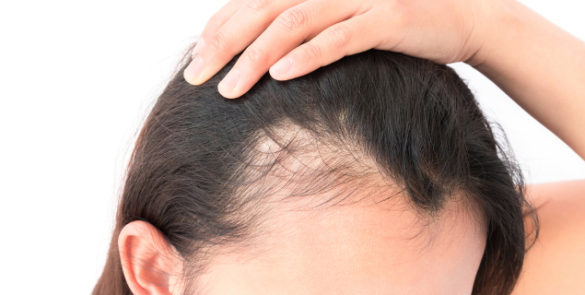Alopecia areata is the most common cause of alopecia in both men and children (1.7% of individuals would be affected during their lifetime). It can very rarely be present at birth, in a decalving form; the reports of congenital patches of discomfort remain questionable. Alopecia areata is, for most authors, a pathology of autoimmune origin appearing on a genetically predisposed ground. The prevalence of other autoimmune diseases is increased (Hashimoto’s thyroiditis, vitiligo, connective tissue diseases, celiac disease, etc.).

The plates are generally completely gabres but the hair holes are visible; they extend centrifugally and can affect the entire scalp (total lopsided alopecia), even the whole body (alopecia areata). They can appear at any point of the integument but certain clinical forms of alopecia areata are individualized:
- The ophiatic alopecia areata begins in the occipital region to extend above the ears and may leave only a band of hair at the top of the skull;
- Sisaïpho alopecia areata is the opposite: a crown of hair persists;
- Alopecia-like alopecia areata is similar to the ophiasic form but the lesion is mainly located on the fronto-temporal glands.
Complementary examinations are rarely necessary. A biopsy would show a lymphocyte infiltrate in a swarm of bees around the hair bulbs. A biological test to look for thyroiditis does not have a systematic justification.
The evolution of alopecia areata is variable and often unpredictable. In most cases, an episode of alopecia areata stops in itself: 60% of the pelopelic patches affecting less than 40% of the skull surface spontaneously and completely regrow within 6 months. However, the plates can sometimes extend to evolve to a pelade and decalvante episodes of alopecia can succeed. On a site susceptible to this pathology, the recurrence of alopecic episodes is frequent during the life, in particular if an extended alopecia arose during the childhood.
As in any immunological pathology, psychological factors come into play, especially in the occurrence of the first episode. The pateints must however be reassured about the organic origin of their alopecia, of which they are not the “culprits-responsible”. The psychological impact of this condition is heavy and the care by the doctor must be attentive and explanatory.
Treatment depends on the age and extent of the alopecia areata. Regarding the alopecia areata, that is to say not decalcifying, the treatment can use corticoids in topical form (level 1 and 2) or steroids injected in situ (for example, triamcinolone acetonide , Kenacort Delay, diluted between 5 and 10 mg / ml, in water for injections). Another frequently used treatment is anthralin (dianthranol), which is applied in brief contact for 15 minutes at a dilution of 0.5 to 3% in a fatty but rinsable carrier. Finally – and in this case, it is often associated with previous treatments to stimulate regrowth – we can use monoxidil 5%. If the alopecia areata is extensive (> 30% of the skull surface) and there is no contraindication, a PUVA therapy can be considered in adults (but relapse is frequent when the treatment is stopped). Studies on UVB therapy are even more modest to conclude. In adults too, contact immunotherapy (diphencyprone, squaric acid dibutylester) may be proposed in case of failure of previous treatments; this treatment is only performed in a few specialized centers. In the particular case of a first episode of recent and very extensive alopecia areata is discussed a bolus treatment of methylprednisolone (Solu-Medrol) to block the evolution. Its effect is less deleterious than conventional oral corticotherapy;
In some cases, treatment-related psychotherapy may be justified, depending on the patient’s terrain and the impact of alopecia.
Sometimes a temporary therapeutic abstention may be proposed: repeated episodes (“boiling” alopecia areata), lack of therapeutic demand.



